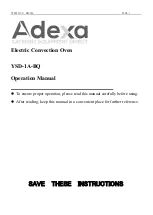
2
R-244M -
Microwave ovens contain circuitry capable of producing very high voltage and current. Contact with following parts
will result in electrocution:-
High voltage capacitor, High voltage transformer, Magnetron, High voltage rectifier, High voltage wires.
REMEMBER TO CHECK 3D
1) Disconnect the supply.
2) Door opened, and wedged open.
3) Discharge high voltage capacitor.
WARNING AGAINST THE CHARGE OF THE HIGH-VOLTAGE CAPACITOR
The high-voltage capacitor remains charged about 60 seconds after the oven has been switched off. Wait for 60
seconds and then short-circuit the connection of the high-voltage capacitor (that is, of the connecting lead from the
high-voltage rectifier) against the chassis using a screwdriver with an insulated handle.
Sharp recommend that wherever possible, fault-finding is carried out with the supply disconnected. In some cases,
it may be necessary to connect the supply with the cover removed to carry out fault investigation in the control
circuitry. In such cases, the high voltage circuit should be disabled as described below to reduce the hazards:-
•
Carry out 3D checks (see above).
•
Disconnect the supply leads from the high voltage transformer, making a note of the polarity. Insulate the
connectors, ensuring they are positioned away from the transformer and fastened there.
•
Connect any relevant test equipment e.g. voltmeter.
•
Reconnect the oven to the supply, then close the door.
•
Note the results of the test, taking care to keep clear of the operational oven.
•
Carry out 3D checks (see above).
•
Reconnect the leads to the transformer. Take care to observe correct polarity.
•
Carry out 4R checks (see below).
Microwave ovens should not be used without a load. To test for the presence of microwave energy within a cavity,
place a cup of cold water on the oven turntable, close the door and set the microwave timer for one (1) minute, set the
power level to HIGH (100%) and push the start key. When the one (1) minute has elapsed (timer at zero) carefully check
that the water is now hot.
AFTER REPAIR REMEMBER TO CHECK 4R
1) Reconnect all leads removed from components during testing.
2) Replace the outer case (cabinet).
3) Reconnect the supply.
4) Run the oven. Check all functions.
When all service work is completed, and the oven is fully assembled, the microwave power output should be checked
and microwave leakage test carried out.
IMPORTANT:
If the oven becomes inoperative because of a blown F8A Fuse, check the monitored latch switch and
monitor switch before replacing the fuse .
WARNING: WIRING / RE-WIRING
Before carrying out any work; carry out 3D checks.
1) Disconnect the supply.
2) Open the door and wedge open.
3) Discharge the high voltage capacitor.
RE-WIRING
1) Wires must not touch:
a) High voltage parts.
b) Parts that become hot.
c) Sharp edges.
d) Movable parts.
2) Positive lock connectors are fitted correctly
3) Wires are connected correctly as per pictorial diagram.
4) No wire leads are trapped by the outer wrap.
WARNING TO SERVICE PERSONNEL
SERVICING



































